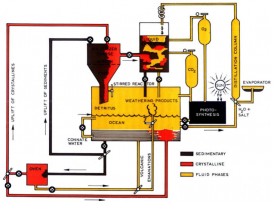Earth System Science (ESS) underpins our contemporary collective and scientific representation of the Earth. It is grounded in the institutional work carried out in the 1980s by NASA and the International Geosphere-Biosphere Program (IGBP) which pinpointed to the existence of a new object of inquiry: the Earth system, composed of interlocking chemical, climatic, and biological processes of different timescales.
Prominent climatologists, oceanographers, geochemists, geophysicists, and ecologists presented ESS as a revolutionary research program that would completely reorganize the disciplines of the Earth sciences around the study of this new object. ESS’ most visible outcome was the constitution of the IGBP, an international research program gathering thousands of scientists to study the Earth system on the short timescales of global changes. Yet, outside the IGBP, ESS also affected the disciplines studying the long-term history of the Earth. The conception of the Earth system promoted by the IGBP was grounded in chemical and biological conceptions of the Earth, and opposed (or complemented) the solely physical conceptions of the Earth at stake in climatology or solid Earth geophysics.
This project traces the genealogy of the “Earth system” concept by following the works of savants and scientists studying the long-term chemistry of Earth’s surface from the late eighteenth century onwards. By the nineteenth century, chemists and geologists investigating living beings’ metabolism, volcanoes’ exhalation, and chemistry of soils and rocks had conceptions reminding that of the contemporary “Earth system.” Sébastian Dutreuil analyzes the historical development of the methods and ontologies underlying the chemical studies of the Earth and their close interrelation with the way the Earth and its history are conceived. This project will ultimately shed light on the history of our representations of the Earth and the global environment.

